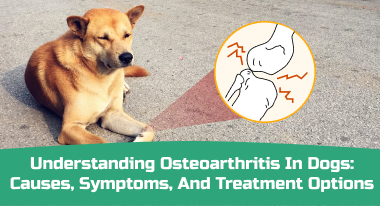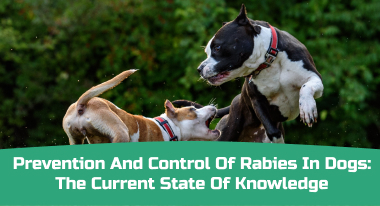Table of Contents
Have you ever noticed something unusual in your furry friend’s eye that looks like a little cherry popping out? Well, don’t fret because that’s what we call “cherry eye.”
It may sound cute, but it’s essential to understand this condition and how to give your pup the best care possible. Let’s dive in and sniff out the common causes and effective treatment options for this eye-catching issue.
What’s Cherry Eye?
Cherry eye, also known as the prolapsed third eyelid or nictitating membrane, is a medical condition that affects dogs. The nictitating membrane is a tissue responsible for secreting tears and is typically concealed in the corner of a dog’s eye. However, in the case of the cherry eye, this membrane grows and protrudes from the eye, creating a noticeable pink bulge.
The term “Cherry Eye” comes from the appearance of the swollen gland, which can resemble a small red cherry or a fleshy mass. While it may look alarming, Cherry Eye is usually not painful for the dog. However, if left untreated, it can cause discomfort, irritation, and a higher risk of eye infections.
Why Do Dogs Get Cherry Eyes?
Dogs get Cherry Eye due to a prolapse of the gland of the third eyelid, which is also known as the nictitating membrane. This gland plays an essential role in the lubrication of the eye, and its prolapse can cause inflammation and irritation.
| Causes | Explanation | Breeds Affected |
| Weakened connective tissue | Genetic predisposition, hereditary factors | Bulldogs, Shar-Peis, Bloodhounds, Cocker Spaniels, Neapolitan Mastiffs, Saint Bernards, and other breeds with loose facial skin |
| Congenital | Present at birth, developmental abnormalities | Bulldogs, Boston Terriers, Beagles, and other brachycephalic breeds |
| Trauma | Injury to the eye area or vigorous scratching | Any breed can be affected |
| Inflammation | Chronic eye infections or allergies | Any breed can be affected |
Cherry Eye in Dogs: Common Causes and Effective Treatment Options
Cherry eye is a condition commonly found in certain dog breeds, such as English bulldogs, pugs, and Boston terriers, caused by a genetic predisposition.
Symptoms usually appear in pets under two years old. There have been instances where sudden overexcitement, shock, or scare can also cause a cherry eye to develop.

Infographic
Cherry Eye in Dogs: Common Causes and Effective Treatment Options Hey pet parents! Have you ever noticed a small red bump on your furry friend’s eye? Well, that could be a cherry eye. So, let’s understand the signs and symptoms to ensure the safety of your beloved pet. #1. Swollen or red third eyelid This may protrude from the eye socket and resemble a cherry. #2. Excessive tearing or discharge from the affected eye Dogs with cherry eyes may have excessive tearing. #3. Rubbing or scratching at the eye Dogs may paw at or scratch the affected eye due to discomfort or irritation. #4. Conjunctivitis Cherry eye can lead to swelling of the conjunctiva, the thin layer covering the white part of the eye. #5. Vision changes In severe cases, cherry eyes can affect a dog’s vision and cause eye dryness, irritation, and discomfort. |
Cherry Eye Diagnosis: What Every Dog Owner Must Know
Understanding the diagnosis process is crucial to cherry eye, a condition affecting our dogs’ eyes. Let’s explore the common methods veterinary professionals use to diagnose cherry eye in our beloved pups.
Observing Symptoms
As attentive pet parents, we play a vital role in recognizing changes in our dog’s eyes. If you notice a red, swollen, or protruding gland in the corner of your pup’s eye resembling a cherry, it’s essential to bring it to your veterinarian’s attention. Describing the symptoms in detail will help the vet assess the situation and determine the appropriate diagnostic steps.
Veterinary Examination
During your visit to the veterinary clinic, the veterinarian will thoroughly examine your furry friend’s eyes. They will carefully observe the cherry eye, noting its appearance, size, and signs of discomfort or inflammation.
Sharing additional information about your dog’s overall health and previous eye conditions will also assist in the diagnosis.
Specialized Tests
Veterinarians may perform additional tests to diagnose accurately and rule out other potential eye problems. These tests help evaluate tear production, identify any corneal ulcers, and confirm the diagnosis of cherry eye.
Fluorescein Staining Test: This non-invasive test involves applying a special dye to the eye’s surface to detect any underlying corneal issues or injuries.
Schirmer Tear Test: This test measures tear production, ensuring your pup’s eyes have adequate moisture. Low tear production can lead to eye discomfort and further complications.
How To Treat Cherry Eye in Dogs?
When it comes to cherry eye, where the third eyelid gland becomes visible, proper treatment is crucial to restore your dog’s eye health. Here are various treatment options available for managing cherry eye in dogs.
Non-Surgical Treatment Options:
Gentle Massage
Sometimes, the veterinarian gently massages the protruding gland back into its normal position. This technique aims to reposition the gland and restore its function. It is vital to have a trained professional perform this procedure to avoid any unnecessary discomfort or complications.
Medications
Your veterinarian may prescribe medications, such as topical eye drops or ointments, to reduce inflammation and promote healing. These medications can help alleviate discomfort and encourage the gland to return to its proper place. It’s essential to follow the veterinarian’s instructions regarding dosage and application.
Surgical Treatment Options
Gland Replacement
Surgical intervention may be necessary if non-surgical methods are ineffective or the cherry eye recurs. During the surgery, the veterinarian will carefully reposition the gland and secure it in its normal position. This procedure helps prevent further prolapse of the gland and restores proper functioning.
Gland Removal
The veterinarian may recommend gland removal in rare cases where the gland is severely damaged or non-functional. While this option eliminates the cherry eye appearance, it may lead to decreased tear production and potential long-term eye dryness. Before deciding, your veterinarian will discuss the potential risks and benefits of gland removal.
Post-Treatment Care
Medication Adherence
Following any prescribed medications, such as eye drops or ointments, is crucial to ensure proper healing and prevent infection. Administer the medications and complete the full course of treatment.
Preventing Eye Irritation
Keeping your dog from rubbing or scratching the affected eye is vital to prevent further irritation or injury. Use an Elizabethan collar (cone) if necessary, and monitor your dog closely during the healing process.
Regular Follow-up Visits
After treatment, regular follow-up visits with your veterinarian are essential to monitor the healing progress and ensure your dog’s eye health is improving. These visits allow for any necessary adjustments to the treatment plan and address any concerns or complications that may arise.
Prevention of Cherry Eye in Dogs
Regarding the cherry eye, prevention is the name of the game! Let’s explore some pet-friendly tips and tricks to help keep those puppy eyes happy and avoid the pesky cherry eye condition.
Regular Eye Care
Gentle Grooming Sessions
Include regular eye checks during your grooming routine. Use a soft cloth or specially formulated pet-friendly wipes to gently clean your dog’s eyes, removing any dirt or discharge. This helps prevent eye irritation and keeps those peepers looking bright.
Tear Stain Prevention
Some dog breeds are prone to tear stains, contributing to eye issues. Regularly wipe away tear stains using pet-safe tear stain removers or natural alternatives recommended by your veterinarian. This helps maintain good eye hygiene and reduces the risk of eye-related problems.
Healthy Lifestyle Habits
Balanced Diet
Provide your furry friend with a high-quality, well-balanced diet that supports their overall health, including their eyes. Consult your veterinarian for nutritious pet foods rich in essential vitamins and minerals.
Fresh Water Always
Ensure your pup has access to clean, fresh water at all times. Staying hydrated promotes overall well-being and helps maintain good tear production, vital for healthy eyes.
Avoid Eye Irritation
Gentle Playtime
During playtime, be mindful of activities that may accidentally lead to eye injuries or irritation. Avoid throwing objects near your dog’s face, and opt for safe toys and games that minimize the risk of accidental eye contact.
Protective Eyewear
Consider protective eyewear made specifically for dogs if your furry friend is exposed to dusty or debris-filled environments. These adorable goggles can shield their eyes and reduce the chances of irritation or foreign objects entering the eyes.
Regular Veterinary Check-ups
Eye Examinations
Include regular eye examinations as part of your routine veterinary visits. Veterinarians can detect early eye issues and provide appropriate guidance to maintain your dog’s eye health.
Conclusion
Cherry eye in dogs is a treatable condition that can be managed effectively with the right treatment plan and care. By understanding the causes, symptoms, and treatment options available for this condition, dog owners can help their pets live comfortable and healthy lives. If you suspect your dog has cherry eye, it is important to seek veterinary care immediately to prevent any complications or long-term damage to your pet’s eye. With proper care and attention, dogs with cherry eye can recover quickly and go on to live happy and active lives.
Disclaimer: The content on the site is for educational purposes only, and it does not provide medical advice. The shared information must not be treated as a substitute for or alternative for medical practitioner advice, diagnosis, or treatment. Regarding any concerns about your pet’s health, seeking veterinary guidance is of utmost necessity. Each pet has specific health, fitness & nutrition needs. Do not disregard, avoid or delay pet health-related advice from veterinarians based on reading the information provided on this site.
FAQ’s
1. Can dogs with cherry eyes heal on their own?
Cherry eye typically does not heal on its own. The gland that has prolapsed requires veterinary intervention to be adequately repositioned.
2. How long does a dog’s cherry eye take to heal?
The time it takes for cherry eye to heal depends on its severity and whether surgery is needed. Non-surgical treatments can take a few weeks to show improvement, while surgery can take several weeks to a couple of months to heal.
3. Is pet insurance going to cover cherry eye?
Pet insurance coverage for cherry eye can vary based on the insurance provider and policy. Some policies may include coverage for treatment, while others may exclude it as a pre-existing condition.
4. How old must a dog be to have cherry eye surgery?
Cherry eye surgery depends not on the dog’s age but on the dog’s health and the severity of the condition.



